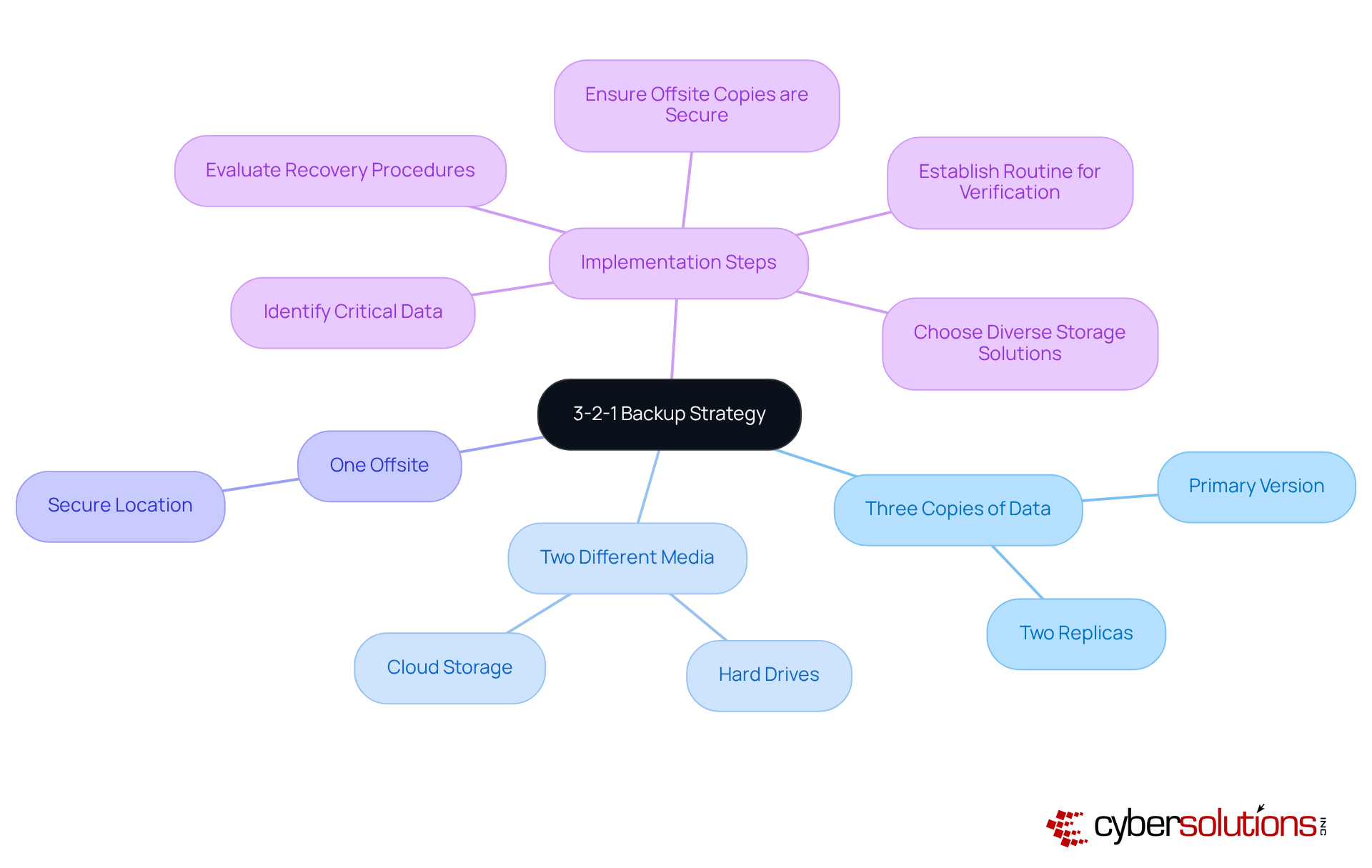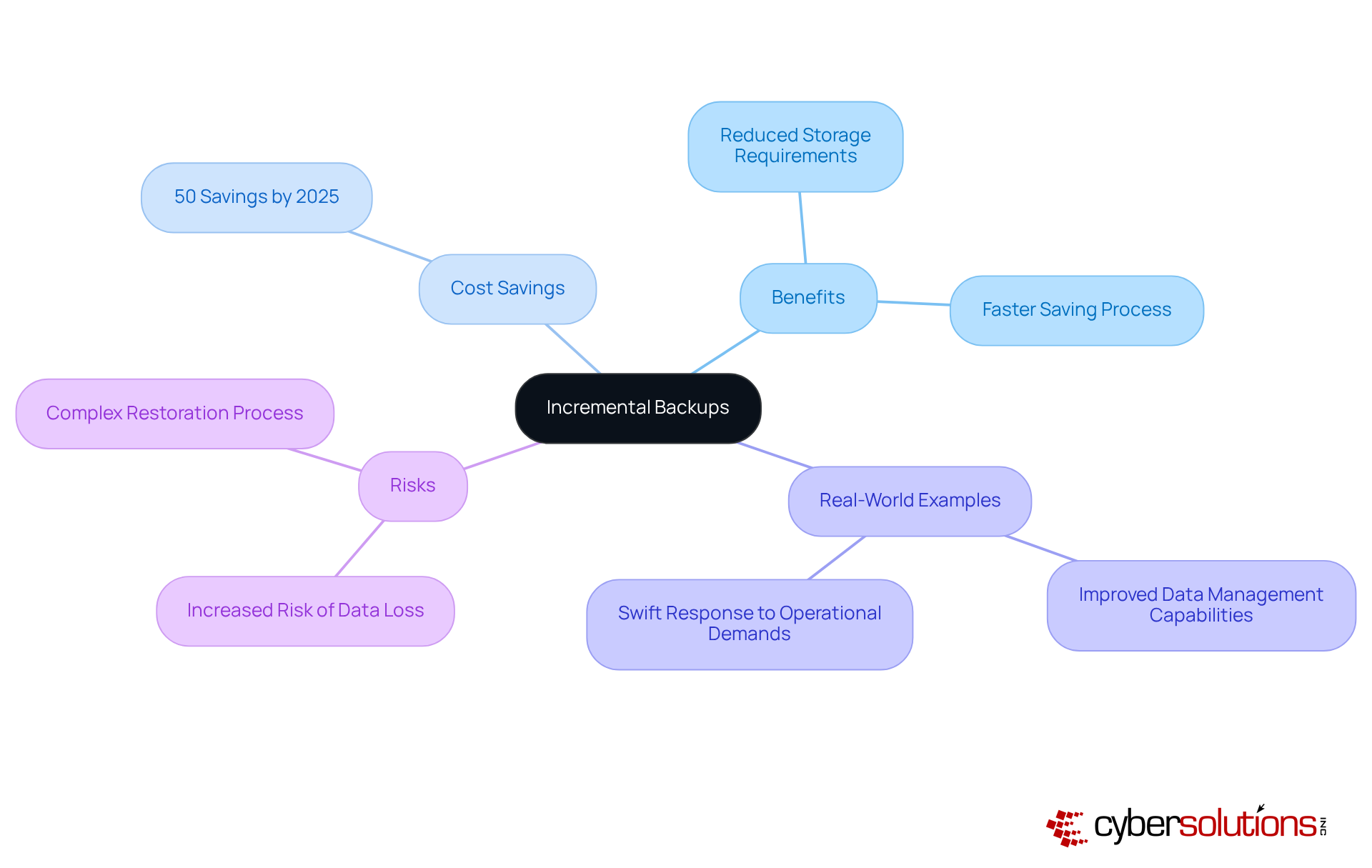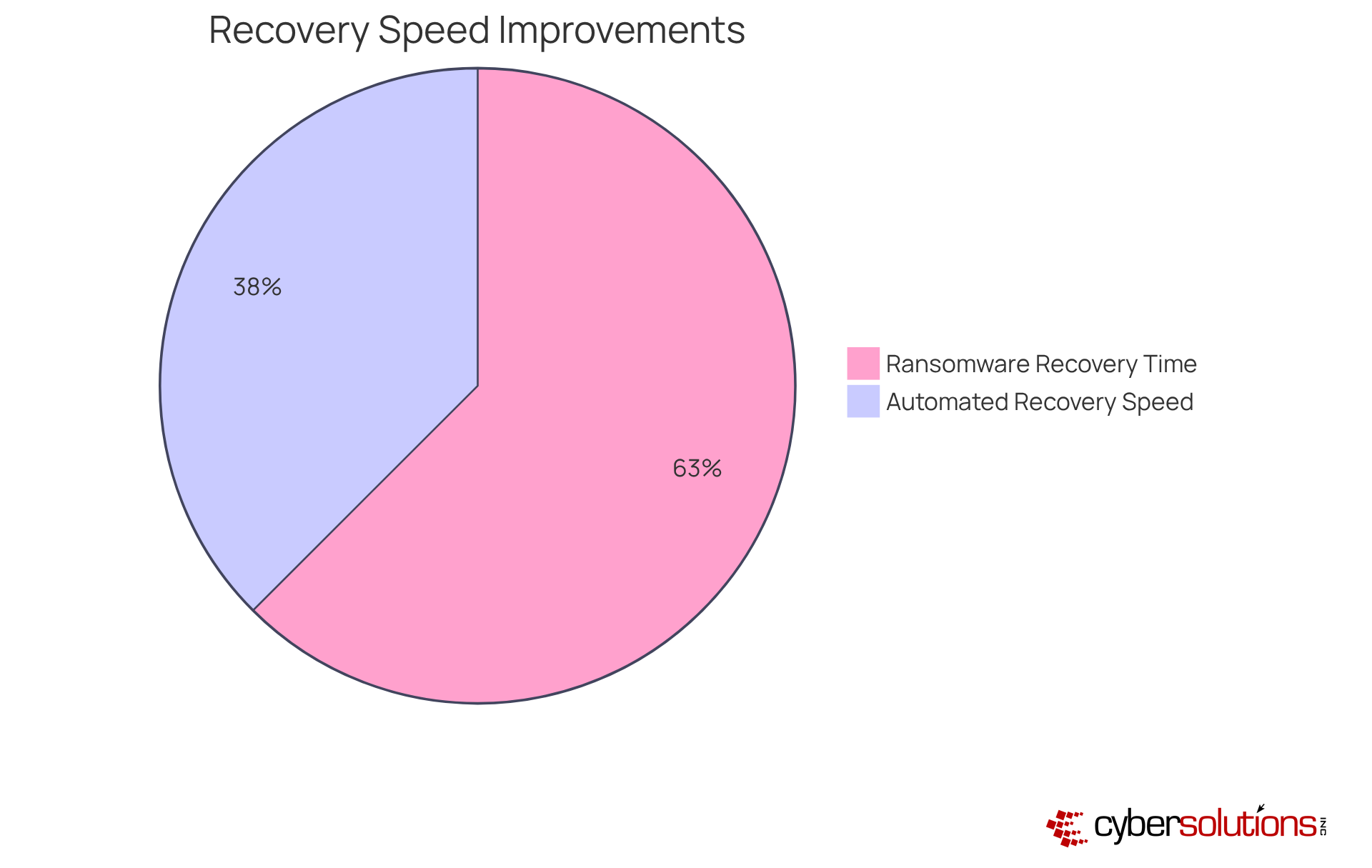
In today’s digital landscape, the threat of data loss and cyber attacks looms larger than ever, making robust data backup strategies essential for C-suite leaders. Organizations face unique challenges that demand immediate attention and action. Implementing effective strategies not only safeguards sensitive information but also fortifies operational continuity and mitigates financial risks associated with data breaches.
One of the most effective approaches is the 3-2-1 backup rule:
This strategy significantly enhances data security and ensures that organizations can recover swiftly from potential threats. Additionally, leveraging cloud storage solutions provides flexibility and scalability, allowing for seamless access to data while reducing the risk of loss.
Automated backups are another critical component. By scheduling regular backups, organizations can ensure that their data is consistently protected without the need for manual intervention. Regular reviews of backup processes and data integrity further bolster security, allowing leaders to identify vulnerabilities before they become critical issues.
As cyber threats continue to evolve, it’s imperative for leaders to stay informed and proactive. Are your current backup strategies sufficient to protect against the latest threats? By adopting these essential data backup strategies, C-suite leaders can not only safeguard their organizations but also foster a culture of security that permeates every level of operation.
In an era where data breaches and cyber threats are ever-present, C-suite leaders must recognize the critical need for robust data backup strategies. Alarming statistics show that a significant percentage of organizations still overlook optimal data preservation practices, leading to an increased risk of catastrophic losses. This article explores ten essential data backup strategies that not only protect sensitive information but also bolster operational resilience, enabling businesses to navigate the evolving landscape of cyber risks.
Can executives afford to ignore these vital measures, or will they step up to secure their organizations against the inevitable threats on the horizon?
Cyber Solutions Inc. recognizes the urgent need for robust cybersecurity measures, especially in the healthcare sector. With a staggering 96% of ransomware attacks targeting storage sites, the stakes have never been higher. Healthcare organizations face unique challenges, including the financial burden of breaches, which averaged $10.93 million in 2023. This alarming trend underscores the necessity for comprehensive data backup strategies that can safeguard sensitive information and ensure operational continuity.
To address these pressing concerns, Cyber Solutions provides an extensive range of data backup strategies and disaster recovery services tailored to the specific needs of various industries. Key features include:
By leveraging cutting-edge technologies and expert insights, Cyber Solutions empowers organizations to focus on their core operations while maintaining a secure and compliant IT environment.
Real-world examples further illustrate the effectiveness of Cyber Solutions' services. After experiencing a significant cyber incident, a manufacturing client implemented a tailored recovery plan that included managed server support and cloud migration. Remarkably, they restored operations within just one working day, minimizing downtime and reinforcing their IT infrastructure against future threats.
As the landscape of managed IT recovery solutions evolves, there is an increasing reliance on automated systems and AI-driven technologies to enhance information protection. Cyber Solutions remains at the forefront of these innovations, providing essential services that enable businesses to navigate the complexities of modern IT environments while safeguarding their critical information.
In conclusion, the importance of strong information protection strategies cannot be overstated. With Cyber Solutions, organizations can not only protect their data but also ensure their operational resilience in the face of ever-evolving cybersecurity threats.

In today's digital landscape, the importance of cybersecurity in healthcare cannot be overstated. With increasing threats from cyberattacks, healthcare organizations face unique challenges that demand robust solutions. The 3-2-1 recovery strategy emerges as a vital framework for information security, highlighting the importance of data backup strategies that require organizations to maintain three copies of their information: one primary version and two replicas. These copies should be stored on two distinct types of media, such as hard drives and cloud storage, with one version securely kept offsite. This approach significantly lowers the risk of information loss from hardware failures, natural disasters, or cyberattacks, enabling businesses to recover swiftly and effectively.
Statistics reveal a concerning trend: only 18% of organizations adhere to optimal procedures for information storage, particularly the 3-2-1 guideline. This gap highlights the pressing need for healthcare CFOs to prioritize data resilience. Implementing data backup strategies like the 3-2-1 strategy can significantly enhance protection against data loss, ensuring that even if one copy is compromised, others remain secure. The financial implications are staggering; the typical cost of inactivity caused by ransomware incidents is estimated at $250,000 per hour, underscoring the necessity of strong recovery solutions.
Real-world examples further illustrate the effectiveness of the 3-2-1 approach. Organizations that adopted this strategy reported quicker recovery times and minimized operational disruptions during cyber incidents, such as ransomware attacks. For instance, following a recent incident, a healthcare provider enhanced its security measures, showcasing the tangible benefits of a structured response plan. Cyber Solutions' swift incident response capabilities exemplify how efficient recovery plans can bolster cybersecurity and ensure business continuity. Information management professionals emphasize that routine verification of copies is crucial to guarantee they are free of errors and can be relied upon during critical times.
To implement the 3-2-1 backup strategy effectively, organizations should prioritize the following steps:
By adopting the 3-2-1 recovery strategy, businesses can enhance their information resilience, safeguard against potential losses, and ensure operational continuity in an increasingly complex digital environment.

Cloud storage solutions are essential for secure and scalable information preservation, enabling businesses to manage vast amounts of data without the burden of extensive on-premises infrastructure. Major providers like AWS, Google Cloud, and Microsoft Azure integrate advanced security features, such as encryption and strict access controls, to protect sensitive information. In fact, 94% of businesses report enhanced security after migrating to the cloud, highlighting the effectiveness of these measures.
As organizations grow, cloud solutions are designed to scale seamlessly, making them an ideal choice for enterprises of all sizes. For example, companies like Skechers have effectively leveraged AWS for their data backup strategies, achieving greater reliability and cost savings through streamlined processes. However, as businesses increasingly adopt cloud technologies, the focus on security remains paramount. A staggering 95% of firms express concerns about cloud security, emphasizing the critical need for robust protective measures in today’s digital landscape.
In this context, application allowlisting stands out as a vital strategy, proactively blocking unauthorized software from executing and significantly reducing the risk of malware and ransomware attacks. Moreover, application allowlisting is instrumental in helping companies meet compliance requirements for standards such as HIPAA, PCI-DSS, and GDPR. C-suite leaders must evaluate cloud storage options by examining the latest security features, including application allowlisting, ensuring they align with their organization’s risk management strategies.

Incremental copies play a crucial role in modern data management by focusing on capturing only the information that has changed since the last save. This method not only significantly reduces storage requirements but also accelerates the saving process. For organizations managing large datasets that undergo frequent changes, this approach is invaluable. It allows for quicker data preservation with minimal disruption to system performance.
By consistently implementing incremental copies, companies can ensure their data remains current without straining their storage capabilities. In fact, projections for 2025 indicate that organizations could save as much as 50% on storage costs compared to traditional full copies. This substantial reduction in expenses highlights the financial benefits of adopting this strategy.
Real-world examples illustrate that firms utilizing incremental copies have improved their data management capabilities. They can respond swiftly to operational demands while maintaining robust data integrity. However, it’s essential to weigh the potential risks associated with this method. For instance, if any incremental copy in the sequence becomes corrupted, the risk of data loss increases.
As IT experts emphasize, data backup strategies that include incremental copies are crucial for companies seeking to enhance their information management approaches while balancing cost and efficiency. This statement underscores the importance of adopting incremental copies as a strategic move in today’s data-driven landscape.

Creating a plan that incorporates data backup strategies is essential in reducing information loss. By utilizing data backup strategies that involve automated copies on a daily, weekly, or monthly schedule, organizations can guarantee reliable information protection without the drawbacks of manual methods. This regularity not only preserves data integrity but also supports effective data backup strategies, streamlining recovery efforts in the event of data loss and enabling businesses to restore operations swiftly.
In 2025, 90% of businesses adhere to the 3-2-1 data preservation strategy, which involves maintaining three copies on two different storage media, with one kept off-site. This indicates an increasing awareness of the significance of data backup strategies in sustaining operational continuity. IT leaders stress that automating data backup strategies not only lowers the risk of human mistakes but also improves overall efficiency. As Yuman Chau notes, "Organizations must recognize drill tests not just as routine protocol, but as critical evaluations that can reveal actionable insights."
Organizations that have adopted automated data backup strategies report enhanced recovery times and minimized downtime, highlighting the concrete advantages of these strategies. To establish automated recovery schedules as part of their data backup strategies, organizations should:
This proactive approach to implementing data backup strategies is essential for safeguarding sensitive information and ensuring business resilience.

Establishing offsite storage is essential for a robust information protection plan. In today's digital landscape, where threats loom large, these copies safeguard against local disasters like fires, floods, or theft, ensuring that vital information remains accessible even in dire situations. By leveraging cloud storage or specialized offsite facilities, organizations can maintain secure backups of their data, significantly enhancing resilience and compliance with industry regulations.
In 2025, approximately 90% of companies recognized the value of offsite storage solutions, acknowledging their effectiveness in mitigating risks associated with data loss. Disaster recovery experts strongly advocate for remote storage, highlighting that it not only shields against local incidents but also enables faster recovery times. For instance, companies like Lyco Direct have successfully implemented hybrid Disaster Recovery as a Service (DRaaS) solutions, reducing their recovery times from over five hours to under one hour. This transition not only minimizes operational downtime but also underscores the critical need for reliable recovery plans.
Ultimately, offsite backups are a vital component of any comprehensive data backup strategies for protecting information. They provide peace of mind and ensure business continuity in the face of unforeseen challenges. Are you prepared to safeguard your organization's data? Embrace offsite storage solutions today and fortify your information protection plan.

In today's digital landscape, consistently checking copies is crucial for ensuring that sensitive information remains secure and retrievable. This process not only involves testing auxiliary files but also confirming their ability to be restored successfully. Organizations must implement automated verification processes to minimize the risk of unnoticed information corruption. By ensuring that copies are reliable, companies can avert costly interruptions and data loss during restoration efforts.
The implications of neglecting this practice can be severe, especially in the healthcare sector where data integrity is paramount. Cybersecurity threats are evolving, and healthcare organizations face unique challenges that require robust solutions. By prioritizing the verification of data copies, CFOs can safeguard their organizations against potential breaches and ensure compliance with regulatory standards.
Ultimately, investing in reliable data management practices is not just a precaution; it's a necessity. Cyber Solutions can effectively address these challenges, providing the tools needed to maintain data integrity and security. Are you prepared to take action and protect your organization from the risks of data loss?

In today's digital landscape, the importance of cybersecurity in healthcare cannot be overstated. Automated recovery solutions are revolutionizing information protection by minimizing the need for manual involvement. These advanced systems can be programmed to execute data backup strategies at regular intervals, ensuring reliable data protection without relying on personnel to remember these critical tasks. This automation significantly reduces the risk of human error, enabling IT teams to focus on more strategic initiatives, ultimately enhancing overall operational efficiency.
Statistics reveal that organizations employing automated recovery systems experience a notable decrease in downtime and data loss incidents. For example, companies that adopt these automated solutions report a remarkable 30% increase in recovery speed compared to those that depend on manual processes.
IT leaders emphasize the necessity of optimizing information protection procedures through automation. As one expert aptly stated, "Automation is not just about efficiency; it's about creating a resilient infrastructure that can withstand evolving cyber threats." Practical examples underscore this assertion: a healthcare provider recently implemented an automated recovery system, resulting in a 50% reduction in recovery time after a ransomware attack. This highlights the crucial role of automation in modern data backup strategies for information protection.
Moreover, adhering to the traditional 3-2-1 storage guideline—maintaining three copies of data on two different media, with one copy stored off-site—can further bolster information protection efforts. By integrating data backup strategies, healthcare organizations can significantly enhance their resilience against cyber threats.

Encrypting stored information is not just a precaution; it’s a necessity for safeguarding sensitive details from unauthorized access. By transforming data into a secure format that can only be accessed with the correct decryption key, organizations can effectively shield their files from cyber threats. The urgency of this measure is underscored by the fact that a staggering 72 percent of businesses faced ransomware attacks in 2023. This alarming statistic highlights the critical need for robust encryption strategies to mitigate such risks and protect valuable information.
To implement effective encryption, organizations must adopt strong protocols that meet industry standards. This means selecting encryption algorithms that offer a high level of security and ensuring that encryption keys are managed with utmost care. Regular audits and updates to encryption practices are essential to keep pace with evolving threats, ensuring that security measures remain effective.
Cybersecurity experts emphasize that encrypting stored information is a cornerstone of a comprehensive security strategy. As one specialist aptly noted, "Effective recovery planning isn’t solely about having an alternative solution; it’s about designing a layered strategy that prioritizes swift restoration and resilience." This layered approach not only bolsters data security but also aids in compliance with regulatory requirements regarding data protection, helping organizations maintain trust with clients and stakeholders.

Organizations must prioritize regular evaluations of their recovery plans to ensure effectiveness in a landscape marked by evolving business needs and technological advancements. This proactive approach involves assessing the sufficiency of current recovery solutions, updating schedules, and integrating new technologies as they emerge. By adjusting recovery plans, organizations not only bolster their resilience against information loss but also ensure compliance with industry regulations.
Consider this: 30.2% of technology leaders assert that essential data preservation is the most critical step in preventing and recovering from data loss. As one technology leader aptly noted, "Having a strong recovery plan is not just a precaution; it's essential for survival in today's digital environment." Furthermore, as companies increasingly rely on cloud solutions, it's projected that 75% of enterprises will adopt Data Protection as a Service (BaaS) by 2028. This shift allows organizations to outsource their data preservation processes, enhancing scalability and security.
Regularly revising data backup strategies can significantly mitigate risks associated with information loss. Alarmingly, 93% of firms that experience information loss for over ten days face insolvency within a year. For instance, a mid-sized healthcare company suffered substantial operational disruptions and lost customer trust after failing to recover data lost due to a ransomware attack. By fostering a culture of continuous improvement in their data protection methods, organizations can safeguard their operations and maintain customer confidence.
Moreover, businesses should consider the four types of backups—full, differential, incremental, and mirror—to develop comprehensive data backup strategies tailored to their specific needs. This strategic approach not only enhances data security but also fortifies the organization's overall resilience.

The importance of effective data backup strategies cannot be overstated, especially for C-suite leaders facing the complexities of modern cybersecurity threats. By prioritizing robust backup solutions, organizations not only protect sensitive information but also ensure operational continuity amid potential data loss incidents.
Various strategies stand out, including:
Each method plays a vital role in a comprehensive data protection plan, enhancing resilience against cyberattacks and minimizing the financial repercussions of data breaches. Regular verification, automation, and encryption further emphasize the need for a proactive approach to safeguarding organizational data.
As the digital landscape evolves, businesses must adapt their backup strategies to meet emerging challenges. By embracing these best practices, C-suite leaders can strengthen their organizations against potential threats and cultivate a culture of resilience. Taking decisive action today will not only protect valuable data but also instill confidence among stakeholders and clients, ensuring a secure and sustainable future for the organization.
What cybersecurity challenges do healthcare organizations face?
Healthcare organizations face significant cybersecurity challenges, including a high financial burden from breaches, which averaged $10.93 million in 2023, and a staggering 96% of ransomware attacks targeting storage sites.
What services does Cyber Solutions Inc. offer for data backup and disaster recovery?
Cyber Solutions offers a range of services including 24/7 help desk support, endpoint protection, and customized disaster recovery plans tailored to the specific needs of various industries.
How did a manufacturing client benefit from Cyber Solutions' services after a cyber incident?
The manufacturing client implemented a tailored recovery plan that included managed server support and cloud migration, enabling them to restore operations within one working day and minimize downtime.
What is the 3-2-1 backup strategy?
The 3-2-1 backup strategy requires organizations to maintain three copies of their data: one primary version and two replicas, stored on two different types of media, with one version kept offsite.
Why is the 3-2-1 backup strategy important for organizations?
This strategy significantly reduces the risk of data loss from hardware failures, natural disasters, or cyberattacks, ensuring businesses can recover swiftly and effectively.
What percentage of organizations adhere to optimal information storage procedures like the 3-2-1 guideline?
Only 18% of organizations follow optimal procedures for information storage, highlighting a gap that needs to be addressed.
What are the financial implications of ransomware incidents?
The typical cost of inactivity caused by ransomware incidents is estimated at $250,000 per hour, emphasizing the necessity for strong recovery solutions.
What steps should organizations take to implement the 3-2-1 backup strategy effectively?
Organizations should identify critical data for protection, choose diverse storage solutions, establish a routine for creating and verifying copies, ensure offsite copies are secure, and consistently evaluate recovery procedures.
What are the benefits of using cloud storage solutions for data backup?
Cloud storage solutions provide secure and scalable options for data preservation, enabling businesses to manage large amounts of data without extensive on-premises infrastructure.
How do major cloud providers enhance data security?
Major providers like AWS, Google Cloud, and Microsoft Azure implement advanced security features such as encryption and strict access controls to protect sensitive information.
What concerns do businesses have regarding cloud security?
A significant 95% of firms express concerns about cloud security, highlighting the critical need for robust protective measures.
What is application allowlisting and why is it important?
Application allowlisting is a strategy that proactively blocks unauthorized software from executing, significantly reducing the risk of malware and ransomware attacks, and helping companies meet compliance requirements for various standards.